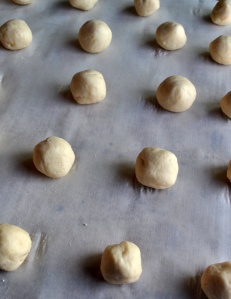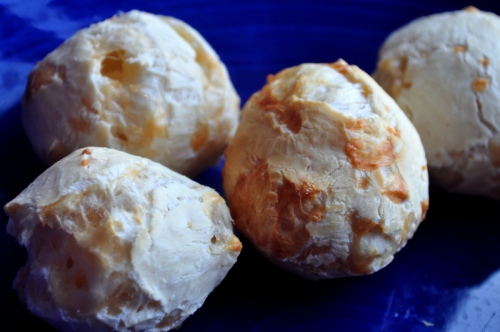I have to admit I loved this months Daring Bakers Challenge. Why? Because even after looking at the recipe several times this month I just got around to trying it out today and was thrilled to see how fast it came together. 5 minutes to mix it together, 20 minutes in the oven and then you are rewarded with little magic puffs, crispy on the outside and pillowy soft on the inside. Oh, did I forget to mention they are filled with cheesy goodness? I would say these are the Brazilian version of French gougères. But different. And gluten-free. Isn’t that a nice bonus? This is a recipe worth keeping for when you have company over with dietary needs that you normally don’t cook for. Like gluten-free cooking. the secret ingredient is sour cassava (tapioca) starch. Made from the yucca plant, the sour tapioca starch undergoes a natural fermentation process and the texture is more granular before baking than regular tapioca flour. Our host this month, the lovely Renata from“Testado, Provado & Aprovado!”, has this to say about the starch:
“TAPIOCA STARCH (also known as CASSAVA STARCH) is the main ingredient of Pão de Queijo. Here in Brazil there are two types: REGULAR and SOUR. The regular type is easier to find in other countries, but if you are lucky enough to find the sour type in your area, I highly recommend you try it (quantities will be provided when applicable). It looks pretty much like any other starch, powdery and white, sometimes it has little granules.
You can find tapioca starch at amazon.com:
Regular Tapioca starch (tapioca flour)
Sour Tapioca Starch (this is a Brazilian brand, quite overpriced. Here in Brazil it costs around US$ 2!)”

Here in Calgary I had no problem finding the sour starch at my local South American market (yes, I have a South American market down the street). I hope that it is just as easy for you (try looking in the spanish section). Otherwise, just use regular tapioca flour.
The second most import ingredient is cheese. The authentic recipe calls for “Queijo Minas Curado” which is typical from Minas Gerais. They did not have this at the store so I relied on what I had in the fridge, smoked applewood cheddar. I don’t know what the other cheese tastes like, Reneta compares it to Monterey Jack, but the applewood cheddar was AMAZING.
These are super simple to make, and are best are best eaten straight from the oven, or warm if you can wait that long. Keep a batch of rolled dough balls in the freezer to bake straight out of the freezer. Roll smaller balls so when company pops by they are the perfect accompaniment with cocktails, or larger balls for a dinner side dish or Panini roll.
I made the traditional version, but you must visit Renata’s site to get the two other versions. If I only had a waffle iron… I also cut the recipe down to 1/4 since there was just the three of us but next time (and there will be a next time) I will make the full batch and freeze the uncooked dough balls. Bake On!
TRADITIONAL PÃO DE QUEIJO
Servings:
Yields about 80 small balls
Ingredients:
500 gm (4 cups) tapioca starch (If you have access to sour tapioca, you can use 250gm (2 cups) of each)
1 cup (250 ml) whole milk
2-3/4 tablespoons (40 ml) (1½ oz) (40 gm) butter
1 teaspoon (5 ml) (3 gm) salt (or to taste depending on how salty your cheese is)
3 cups (750 ml) (9 oz) (250gm) Monterey Jack Cheese (or another cheese of your liking, or a mix of cheeses), coarsely grated
1 to 3 large eggs
Directions:
Heat milk, butter, and salt in a small sauce pan until it comes to a boil. Watch closely as it may boil over. Remove from heat and set aside.
Sift the tapioca starch into a large bowl.
Pour the hot liquid mixture over the tapioca and start stirring with a fork. The milk mixture will not be enough to form a dough yet. You will have a lumpy mixture, that’s what it is supposed to be.Keep stirring with the fork, breaking down the lumps as much as you can, until the mixture cools down to warm.
Preheat your oven to moderately hot 400° F/200° C/gs mark 6
Add the grated cheese to the tapioca mixture and mix well, now using your hands.
Lightly beat the eggs with a fork and add little bits until the dough comes together into a soft but pliable dough. You only have to knead it a bit, not as much as you knead a yeasted bread. It’s OK if it is slightly sticky.Form balls with the dough and place them on a baking sheet lined with parchment paper or silicon mat or lightly greased with vegetable oil. If necessary, you can oil your hands to make shaping easier. The size of the balls may vary from small bite-sized balls to the size of ping-pong balls. They will puff up quite a bit after baking.25 minutes or until they just start to brown on the bottom. You may have golden spots of cheese on the crust. Don’t over-bake as they will get hard and bitter.
NOTE: If your dough gets too soft and sticky to shape balls, you can always add a bit more tapioca starch or pop the dough into a piping bag and pipe the dough on a baking sheet.
Additional Information from Renata:
Read more at http://leitesculinaria.com/32757/recipes-brazilian-cheese-rolls.html#Xhw8sSPoMEYCkob6.99
Read more at http://leitesculinaria.com/32757/recipes-brazilian-cheese-rolls.html#Xhw8sSPoMEYCkob6.99
Read more at http://leitesculinaria.com/32757/recipes-brazilian-cheese-rolls.html#Xhw8sSPoMEYCkob6.99
















